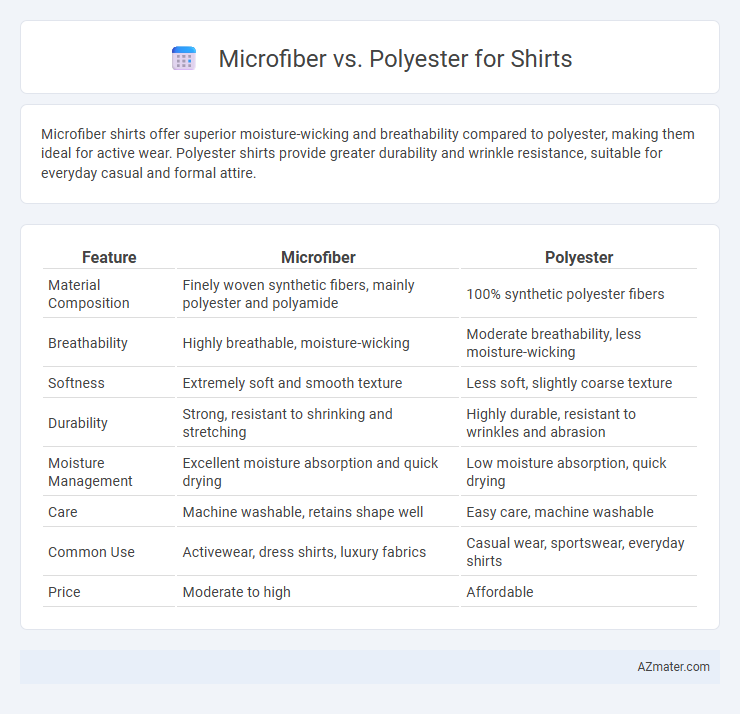Microfiber shirts offer superior moisture-wicking and breathability compared to polyester, making them ideal for active wear. Polyester shirts provide greater durability and wrinkle resistance, suitable for everyday casual and formal attire.
Table of Comparison
| Feature | Microfiber | Polyester |
|---|---|---|
| Material Composition | Finely woven synthetic fibers, mainly polyester and polyamide | 100% synthetic polyester fibers |
| Breathability | Highly breathable, moisture-wicking | Moderate breathability, less moisture-wicking |
| Softness | Extremely soft and smooth texture | Less soft, slightly coarse texture |
| Durability | Strong, resistant to shrinking and stretching | Highly durable, resistant to wrinkles and abrasion |
| Moisture Management | Excellent moisture absorption and quick drying | Low moisture absorption, quick drying |
| Care | Machine washable, retains shape well | Easy care, machine washable |
| Common Use | Activewear, dress shirts, luxury fabrics | Casual wear, sportswear, everyday shirts |
| Price | Moderate to high | Affordable |
Introduction to Microfiber and Polyester Shirts
Microfiber shirts, made from ultra-fine synthetic fibers, offer exceptional softness, moisture-wicking properties, and durability compared to traditional polyester shirts. Polyester shirts are crafted from synthetic polymers known for their strength, wrinkle resistance, and quick-drying capabilities, making them a popular choice for activewear and casual wear. Both materials are lightweight and easy to care for, but microfiber's finer fiber structure provides superior breathability and a smoother texture ideal for performance and comfort.
What Is Microfiber Fabric?
Microfiber fabric is composed of ultra-fine synthetic fibers, typically measuring less than one denier in diameter, which makes it exceptionally soft, lightweight, and breathable compared to traditional polyester. These microscopic fibers create a dense weave that enhances moisture-wicking properties, durability, and resistance to wrinkles, making microfiber shirts ideal for activewear and everyday comfort. Unlike standard polyester, microfiber offers superior touch and moisture management, contributing to better temperature regulation and overall fabric performance.
What Is Polyester Fabric?
Polyester fabric is a synthetic textile made from petroleum-based polymers, known for its durability, resistance to wrinkles, and moisture-wicking properties, making it popular for shirts. It offers high tensile strength and retains color well, which ensures vibrant and long-lasting garments. Compared to microfiber, polyester tends to be less soft but more affordable and easier to care for in everyday wear.
Key Differences Between Microfiber and Polyester
Microfiber shirts are made from extremely fine fibers, usually less than one denier, which provide superior softness, breathability, and moisture-wicking properties compared to standard polyester shirts. Polyester fabric, derived from synthetic polymers, offers durability, resistance to wrinkles and shrinkage, and tends to be less expensive than microfiber. The key differences lie in microfiber's finer texture and enhanced comfort, while polyester excels in cost-effectiveness and sturdy performance for everyday wear.
Comfort and Feel: Microfiber vs Polyester Shirts
Microfiber shirts offer superior softness and moisture-wicking properties, making them highly comfortable for all-day wear compared to traditional polyester. Polyester shirts, while durable and lightweight, often lack the breathable and smooth texture of microfiber, which can result in a less comfortable feel during extended use. The finer fibers in microfiber enhance air circulation and reduce irritation, providing a more pleasant wearing experience than regular polyester fabrics.
Durability and Longevity Comparison
Microfiber shirts, composed of ultra-fine synthetic fibers, exhibit superior durability by resisting wear and tear, stretching, and shrinking better than traditional polyester fabrics. Polyester, while strong and resistant to wrinkles and abrasions, tends to lose shape and degrade faster under frequent washing and high-heat conditions. The enhanced fiber structure of microfiber results in longer-lasting shirts that maintain softness and color retention over extended use compared to standard polyester.
Moisture-Wicking and Breathability Features
Microfiber shirts excel in moisture-wicking due to their ultra-fine fibers that draw sweat away from the skin, enhancing drying speed and comfort during intense activities. Polyester fabrics also offer good moisture management but tend to be less breathable compared to microfiber, which allows for better air circulation and temperature regulation. Both materials provide lightweight options, but microfiber's superior breathability makes it ideal for high-performance athletic wear requiring efficient moisture control.
Care and Maintenance for Both Fabrics
Microfiber shirts require gentle washing in cold water and low heat drying to maintain their softness and prevent fiber damage, while polyester shirts are more durable, tolerating machine wash in warm water and higher heat drying without significant wear. Avoid using fabric softeners on microfiber as they can reduce its moisture-wicking properties; polyester is less sensitive but excessive heat may lead to shrinkage or melting. Regular care of both fabrics ensures longevity, with microfiber needing delicate handling and polyester providing easier maintenance and quicker drying times.
Environmental Impact: Microfiber vs Polyester
Microfiber, a subset of polyester, often raises concerns due to its smaller fibers that shed more microplastics into waterways compared to standard polyester fabrics. Polyester, derived from petroleum, contributes significantly to fossil fuel depletion and has a higher carbon footprint during production. Both materials are non-biodegradable, but microfiber's enhanced shedding intensifies environmental pollution, making sustainable alternatives or recycled options crucial for reducing ecological harm.
Which Is Better for Shirts: Microfiber or Polyester?
Microfiber offers superior softness, moisture-wicking properties, and breathability compared to traditional polyester, making it ideal for comfortable, high-performance shirts. Polyester excels in durability, wrinkle resistance, and cost-effectiveness, which suits budget-friendly, long-lasting apparel. Choosing between microfiber and polyester depends on prioritizing comfort and moisture management versus affordability and resilience in shirt fabrics.

Infographic: Microfiber vs Polyester for Shirt
 azmater.com
azmater.com